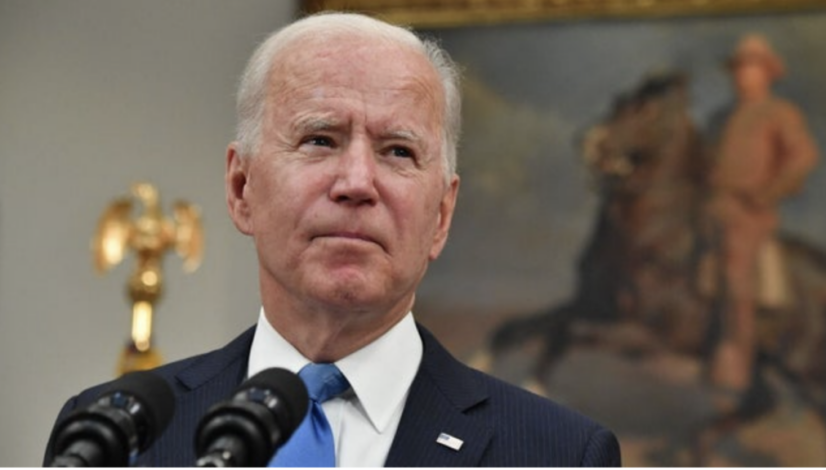Inflation becomes political threat to big-spending Democrats

Voters are beginning to blame President Biden for soaring prices on everything from diapers to chicken. While the president’s grandiose $1.9 trillion American Rescue Plan threw excess stimulus onto an economy already heating up, it isn’t the only reason the cost of living is going up.
No, we also have to blame the Federal Reserve, which continues to flood the economy with cheap money. The Fed is behind the curve, and they know it. Hence the baby steps they recently took towards reining in the gusher of money coursing through the economy, which has helped push core inflation to a near-30-year high. Fed officials now foresee interest rates creeping up to 0.6 percent by the end of 2023; at their last meeting in March, they expected no rate change until at least 2024.
Fed Chair Jerome Powell also announced after their recent policy meeting that at some point there would be a discussion of pulling back on its $120 billion per-month bond-buying, maybe.
Powell actually said: “You can think about this meeting that we had as the ‘talking about talking about tapering.’”And people thought Alan Greenspan was opaque.
Inflation has been above expectations for several months, and hiring is sluggish. The high priests in charge argue with the cohesion of a Gregorian chant that the surge in prices is “transitory,” caused by supply bottlenecks and other one-time effects. And they continue to wait for unemployment to drop to pre-COVID levels.
But they don’t really know. We have never seen the government step in to resuscitate an economy that the same government just recently shut down. We have never in peacetime experienced such enormous amounts of money spent by Congress, nor such a gigantic amount of bond-buying by the Federal Reserve. We are truly in uncharted waters.
Nonetheless, Powell and his merry band continue to sing the “nothing to see here” chorus, relying on a tumble in lumber prices to justify their nonchalance.
Just for the record, lumber prices are down sharply from their recent highs, but remain about three times the average level of the past 10 years.
It is quite possible, as Fed economists scramble to explain away surging prices, that they have got it wrong. Why? It appears our money savants missed these important signals:
- Consumer net worth soared $26 trillionover the 12 months ending March 31 of this year, despite the devastation wrought by COVID-19. Ed Hyman, a leading Wall Street economist, has been highlighting the accumulating wealth for many months, pointing out not only the total winnings from rising stock and home prices but also the positive impact such gains historically have had on the economy. The relationship is quite clear; increased consumer net worth drives spending, with about a six-month lag. In its pessimistic projections of growth coming out of the pandemic-related shutdowns, the Fed seems to have ignored this very positive indicator.
- The Fed also seems to have whiffed on foreseeing the negative impact that federal incremental unemployment benefits might have on the labor pool. A study by economist Steve Moore and his colleagues at the right-leaning Committee to Unleash Prosperity shows clearly that in 19 states families with two unemployed parents and two children can “earn” up to $100,000 per year in various government benefits, including the extra unemployment payments, while staying home. Why would they go back to work?
- As a consequence of excessive government largesse, businesses are having to pay up for workers; in what could become a vicious cycle, they are passing those costs along to consumers.
- Businesses panicked last year as the shut-downs rolled through the country and the world. CEOs had no idea how long the closings would last, or how their customers would respond. They did what they needed to in order to survive; in particular, they stopped ordering new goods. Inventories sank to near-record lows relative to sales, pretty much guaranteeing that any upturn in demand would lead to the scramble for merchandise and bottlenecks such as we are seeing now.
In sum, there were warning signs aplenty that a recovery, pumped up by stimulus spending, extra-low interest rates and giant bond-buying, was likely to boom and lead to dislocations. Why were so few paying attention?
Politics undoubtedly played a role. Democrats and their media allies trash-talked the economy during the final six months of 2020, hoping the COVID-led downturn would dampen President Trump’s reelection prospects.
Also, Jay Powell pushed aggressively for Congress to pass recovery aid, repeatedly arguing that his lenient monetary policy could not right the teetering economy all by itself. As lawmakers stepped up, he could hardly step down.
And newly empowered Democrats could not let a good crisis go to waste.
Many of us warned that the December $900 billion stimulus was overly generous, noting that the economy was already rapidly recovering, and that the $1.9 trillion American Rescue Plan was downright dangerous. But that was the minority view, drowned out by exuberant Democrats eager to spend.
Today, sounding alarms about inflation is also the minority view. But a recent Harvard/CAPS Harris poll shows that 88 percent of the country is “somewhat” or “very” concerned about inflation. Moreover, only 18 percent of respondents (in a very pro-Biden poll) is “very confident” that the Biden administration will be able to “keep inflation at bay” — the same number that thinks the Fed will be able to do so.
When asked what causes inflations, those surveys cited “massive government spending,” “significant amounts of money being injected in the economy by the Fed” and “uncontrollable government deficits.”
Sounds like voters may get it right. Democrats, and Joe Biden, should be wary. Inflation could be the big campaign issue in 2022, and today they are on the wrong side of it. Just like Jay Powell.
https://thehill.com/opinion/finance/559107-inflation-becomes-political-threat-to-big-spending-democrats?rnd=1623980244
Published on The Hill



